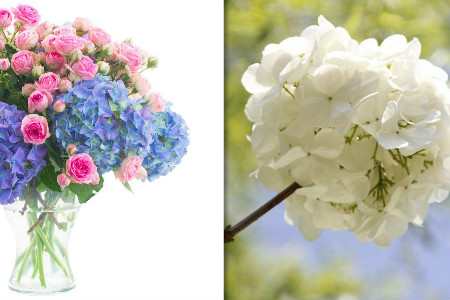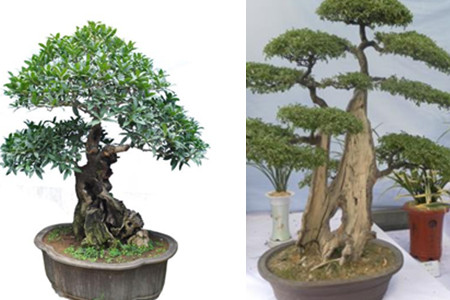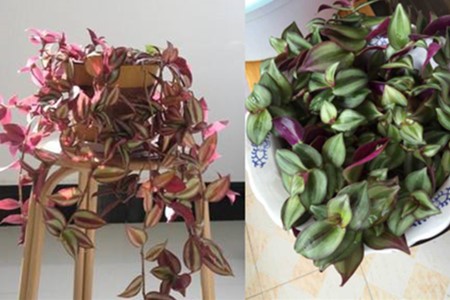Hydrangea blossoms several times a year to explain the correct planting method

Many people will choose to keep pets or grow flowers and trees when they are bored in their spare time, and most of them will choose to plant green plants. As Hydrangea has a very good ornamental value, so many people also like to plant this kind of plant at home.
Hydrangea blossoms several times a year
In general, hydrangea blossoms in June every year, but unlike other flowers, the plant only blossoms once a year. However, because the characteristic of hydrangea flowering is that both new and old branches will blossom, so often the flowers of old branches fail before they begin to blossom, which leads to the illusion that they bloom twice a year.
2. How to grow hydrangea
1. Planting environment
Although Hydrangea is a kind of shade-tolerant plant, it doesn't mean that they don't like sunlight. When planting hydrangea in a sunny environment, its branches will become stronger, less likely to fall down, and the flowers will bloom more brightly. But Hydrangea cold tolerance is relatively weak, in the environment of ten degrees below zero, remember to do a good job in the protective measures of the old branches. If the old branch is frostbitten, it will cause the plant to fail to blossom normally the following year.
2. Planting media and flowerpots
Hydrangea is not very demanding for soil, as long as it has several moisturizing properties. Because of the luxuriant foliage of Hydrangea, it is necessary to ensure that the plant absorbs water from April and does not allow it to become dehydrated. When the temperature is relatively high, it is recommended that you water it twice a day and try not to water the flowers directly when watering. If the flowers and leaves are wet, they can easily get sunburned.
3. Pruning
As the old branches of Hydrangea will differentiate into flower buds in autumn and winter, the pruning of the plant must be completed before autumn. Cut off the residual flowers and aging branches of the plant, and then cut the branches short according to the relevant needs of controlling the plant type. If the planting site is relatively large, it is suggested that you can leave more branches.
4. Fertilization
Because hydrangea has a great demand for fertilizer, and it is also very particular about fertilization. Flower buds differentiate in autumn and winter, so you can fertilize for the first time in autumn. This time fertilization is mainly through compound fertilizer, the second fertilization is in winter, this time fertilization is mainly organic fertilizer. When the plant sprouts in March, liquid fertilizer should be applied every one or two weeks, so it is suggested that we can apply flower fertilizer directly.
5. Cuttage propagation
The propagation mode of hydrangea is mainly cutting, generally after flowering, cutting branches can be cut. Hydrangea this kind of plant also belongs to a very easy to cut plant, the cutting method is also very simple, only need to cut a branch, and then cutting can be done. Although Hydrangea cutting is very easy, but if you use the branches formed by vernalization in winter or early spring for cutting, although it can survive, it is easy to affect the flowering effect of large seedlings.
Through the above detailed introduction, have you mastered the method of planting hydrangea? If you want to plant successfully, then you must master the correct method of reproduction, so that you can grow beautiful flowers.
The eight Immortals bloom twice a year (scientific name: Hydrangea macrophylla), also known as Hydrangea and Ziyang Flower, belongs to the genus Saxifragaceae. The eight Immortals flowers are white and plump, large and beautiful, and their colors can be red and blue, pleasing to the eye and spirit. They are common potted ornamental flowers and trees. The eight Immortals were cultivated earlier in China, and they were planted in the gardens in the south of the Yangtze River built in the Ming and Qing dynasties. The parks built at the beginning of the 20th century are also inseparable from the planting of eight Immortals. Modern parks and scenic spots are planted in pieces to form a landscape.
Baxian flower requires good drainage, rich in humus, more fertile slightly acidic soil, soil consolidation is easy to waterlogging, it is necessary to loosen the soil in time, and the basin should be changed before germination in early spring. Eight immortals like half-yin and half-yang environment, the most afraid of strong direct sunlight, midsummer should be placed in a cool and well-ventilated place, otherwise easy to suffer from sunburn, leaves yellowed and anxious. The leaves of the eight Immortals are more fat and require a lot of water. They can be watered twice a day in midsummer, but they should not be excessive. They should be poured out of the basin after rain. Too much water will cause the fleshy roots to rot. The growth slows down after August, as long as it keeps the basin soil moist, such as improper watering, it will cause withered branches, fallen leaves and rotten roots. In order to control the overdense growth of the plant, the weak branches and flowering branches should be cut off from the base from February to March in early spring to promote the healthy growth of the new shoots. When the new shoots grow to more than 10 cm, the heart can be removed, and the weak buds should be removed in March of the following year to promote the healthy growth of the main and lateral branches. Baxian flower is vulnerable to freezing injury. During the period of low temperature and defoliation, the basin soil can be kept moist, and the overwintering temperature should be kept at about 0 ℃. In order to promote its good dormancy, it can thrive and germinate in the next spring. Part of the leaves can be removed when entering the room at the end of November, keeping 2 ℃ to 3 ℃ at room temperature, the basin soil is slightly wet, the air is unobstructed and away from soot and oil dirt. In order to make Baxian flower blossom twice a year, in addition to strengthening the above measures, heavy cutting can be carried out after the first flowering to promote the germination of new branches, 4 to 6 shoots are selected, the rest are cut off, and the management of water and fertilizer is strengthened. The application of available phosphate fertilizer is increased from July to August, and the second flower can bloom from September to October. How to cultivate hydrangea? Detailed explanation of cutting cultivation techniques of Hydrangea
How to raise hydrangeas? Hydrangea is shaped like hydrangea and likes rich and moist soil. It is a very delicate flower. Most varieties of hydrangea can only be propagated reliably by rooting cuttings. Let's learn the cutting cultivation techniques of Hydrangea.
Preparatory work
Cleaning is essential for successful rooting of hydrangea. Wipe the trimming blade with a rag soaked in alcohol. This kills diseased organisms and prevents pathogens from spreading. Clean the flowerpot. After rinsing in clean water, soak the flowerpot in 1 part of household bleach to 9 parts of water solution for at least 5 minutes. Rinse clean with clean water. Fill the basin with rooting soil (such as the equivalent part of peat and perlite) in the 2-3cm at the edge. Time propagates in the middle and late summer, when the flowers have formed and the stems are still green.
Looking for branches
Find the Hydrangea stem that has not yet blossomed because flowering reduces the concentration of plant hormones in the stem. This hormone promotes rooting. You can test the correct stem development by bending the green stem.
Cut
With a clean pruning shears, remove the top part of the stem that contains several leaves. Cut the stem below the node, which is the area where leaves appear. Cut the stem into shorter pieces, each about 10CM, and contain three to four nodes. Clean up the alcohol pruning shears between each stem cut from the bushes.
Prepare to plant
Prepare a small clean container with some rooting hormones in it. Do not soak the cut branches into the entire container that may contaminate the rooting hormone. If there are leaves, remove the lower two leaves from the cut. Immediately soak the base of the stem in the rooting hormone and apply the end of the fresh cut and any wound caused by the removal of the leaves. Cut off the outer half of the remaining leaves to reduce the use of water when cutting.
Maintain humidity
You need to keep cutting until it takes root, so it needs a wet environment. Place a large, transparent plastic bag at the cutting place and, if necessary, take it off the branch and insert the stump into the pot mixture. Put the cut in a cool place. It will take root in about a week.
- Prev

Does Chinese Flower Bonsai Iron Tree look good? sharing of breeding methods
The Chinese flower bonsai iron tree is usually placed in the office or at home as a bonsai, but the Chinese flower bonsai iron tree generally grows on a single head in the natural state, and is more famous for its flowering, which is called "iron tree blooming".
- Next

We must pay attention to how to raise Violet orchids.
Violet hanging orchid is a very beautiful hanging orchid, now many people like to raise hanging orchid, it is a good choice, raising such a pot of hanging orchid will make your house have the breath of life.
Related
- Fuxing push coffee new agricultural production and marketing class: lack of small-scale processing plants
- Jujube rice field leisure farm deep ploughing Yilan for five years to create a space for organic food and play
- Nongyu Farm-A trial of organic papaya for brave women with advanced technology
- Four points for attention in the prevention and control of diseases and insect pests of edible fungi
- How to add nutrient solution to Edible Fungi
- Is there any good way to control edible fungus mites?
- Open Inoculation Technology of Edible Fungi
- Is there any clever way to use fertilizer for edible fungus in winter?
- What agents are used to kill the pathogens of edible fungi in the mushroom shed?
- Rapid drying of Edible Fungi

